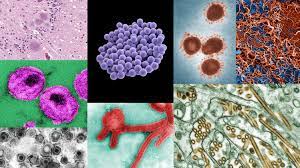There are top 5 leading diseaes in worldwide
I cannot give a subjective opinion on the most important or leading diseases. However, based on available statistics and global health reports, here are the top 5 leading diseases in terms of morbidity and mortality:
Cardiovascular Diseases (CVDs): According to the World Health Organization (WHO), CVDs are the number one cause of death worldwide. This includes heart attacks, strokes, and other conditions that affect the heart and blood vessels.
Cancer: Cancer is the second leading cause of death globally, with an estimated 9.6 million deaths in 2018. It is a group of diseases characterized by the uncontrolled growth and spread of abnormal cells.
Respiratory Diseases: Respiratory diseases, including chronic obstructive pulmonary disease (COPD) and pneumonia, are the third leading cause of death worldwide. According to the WHO, lower respiratory infections alone caused an estimated 2.56 million deaths in 2017.
Diabetes: Diabetes is a chronic condition characterized by high blood sugar levels. It is a leading cause of death and disability worldwide, with an estimated 1.6 million deaths directly attributed to diabetes in 2016.
Alzheimer’s Disease and other Dementias: Alzheimer’s disease and other dementias are a group of brain disorders that affect memory, thinking, and behavior. They are the fifth leading cause of death worldwide, with an estimated 1.8 million deaths in 2019.
Cardiovascular Diseases (CVDs)
Cardiovascular diseases (CVDs) are a group of disorders that affect the heart and blood vessels. They are currently the leading cause of death worldwide, accounting for approximately 17.9 million deaths annually. CVDs include a range of conditions such as coronary heart disease, heart failure, stroke, and peripheral artery disease.
CVDs are often caused by lifestyle factors such as unhealthy diet, physical inactivity, tobacco use, and excessive alcohol consumption. Other factors that can increase the risk of CVDs include high blood pressure, high cholesterol, diabetes, and obesity.
Preventive measures for CVDs include adopting a healthy lifestyle, such as eating a balanced diet, exercising regularly, avoiding tobacco and alcohol, and managing stress. In some cases, medications or surgeries may also be required to treat CVDs. Regular health check-ups and screenings are important to detect and manage risk factors for CVDs.
Cancer
Cancer is a group of diseases characterized by the abnormal growth and spread of cells in the body. It is currently the second leading cause of death worldwide, with an estimated 9.6 million deaths in 2018. Cancer can occur in any part of the body and can spread to other parts through the bloodstream or lymphatic system.
There are many different types of cancer, including lung cancer, breast cancer, prostate cancer, colon cancer, and skin cancer, among others. The causes of cancer are complex and can include genetic, environmental, and lifestyle factors.
Preventive measures for cancer include adopting a healthy lifestyle, such as eating a balanced diet, exercising regularly, avoiding tobacco and excessive alcohol consumption, and protecting the skin from the sun. Early detection through regular screenings and tests can improve the chances of successful treatment.
Treatment for cancer may include surgery, radiation therapy, chemotherapy, immunotherapy, and targeted therapy. The choice of treatment depends on the type and stage of the cancer and the overall health of the patient.
Respiratory Diseases:
Respiratory diseases are a group of disorders that affect the lungs and breathing. They are currently the third leading cause of death worldwide, with lower respiratory infections alone causing an estimated 2.56 million deaths in 2017, according to the World Health Organization.
Respiratory diseases can be caused by a variety of factors, including infections, allergies, environmental pollutants, and genetic factors. Common respiratory diseases include asthma, chronic obstructive pulmonary disease (COPD), pneumonia, and tuberculosis.
Preventive measures for respiratory diseases include avoiding exposure to tobacco smoke and other air pollutants, maintaining good indoor air quality, practicing good hygiene to avoid infections, and getting vaccinated against certain respiratory infections.
Treatment for respiratory diseases depends on the type and severity of the condition and can include medications, oxygen therapy, pulmonary rehabilitation, and in severe cases, mechanical ventilation. Early detection and management of respiratory diseases can help prevent complications and improve outcomes.
Diabetes
Diabetes is a chronic condition characterized by high blood sugar levels. It is currently a leading cause of death and disability worldwide, with an estimated 1.6 million deaths directly attributed to diabetes in 2016.
There are two main types of diabetes: type 1 diabetes, which is an autoimmune condition that usually develops in childhood, and type 2 diabetes, which is often associated with lifestyle factors such as obesity, physical inactivity, and unhealthy diet.
Diabetes can cause a range of complications, including heart disease, stroke, kidney disease, nerve damage, and blindness. It is managed through a combination of lifestyle changes such as eating a healthy diet, engaging in regular physical activity, and maintaining a healthy weight, as well as medications such as insulin and oral hypoglycemic agents.
Preventive measures for diabetes include adopting a healthy lifestyle, maintaining a healthy weight, and getting regular physical activity. Early detection through regular health check-ups and screening tests can also help prevent complications from diabetes.
Alzheimer’s Disease and other Dementias:
Alzheimer’s disease and other dementias are a group of progressive neurological disorders that affect memory, thinking, behavior, and daily activities. They are currently one of the leading causes of disability and dependence among older adults.
Alzheimer’s disease is the most common type of dementia, accounting for 60-80% of cases. Other types of dementia include vascular dementia, Lewy body dementia, and frontotemporal dementia.
The causes of dementia are complex and can include genetic, environmental, and lifestyle factors. There is currently no cure for dementia, and treatment focuses on managing symptoms and improving quality of life.
Preventive measures for dementia include adopting a healthy lifestyle, such as eating a balanced diet, engaging in regular physical activity, avoiding tobacco and excessive alcohol consumption, and managing conditions that can increase the risk of dementia, such as high blood pressure and diabetes.
Early detection through regular cognitive assessments and screening tests can also help with the management of dementia. Additionally, providing support and care for individuals with dementia and their families is an important aspect of dementia management.





